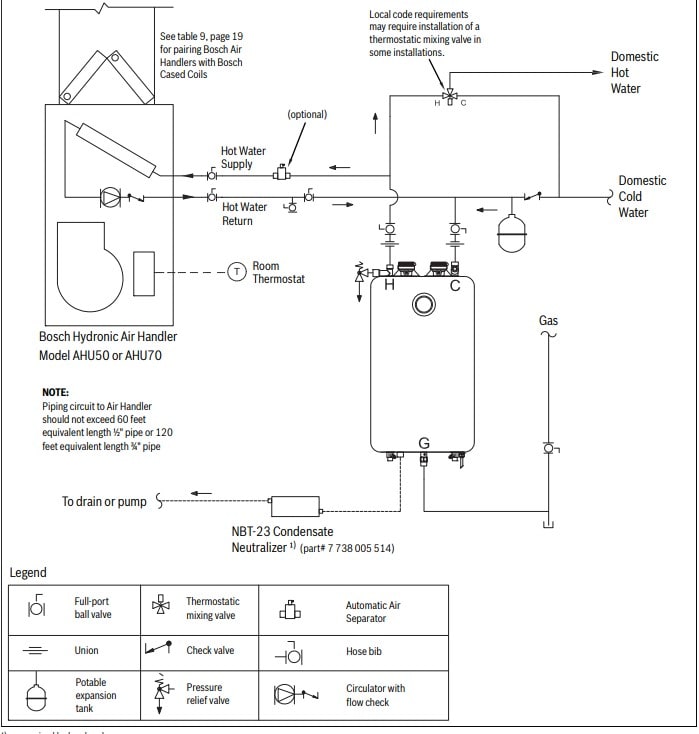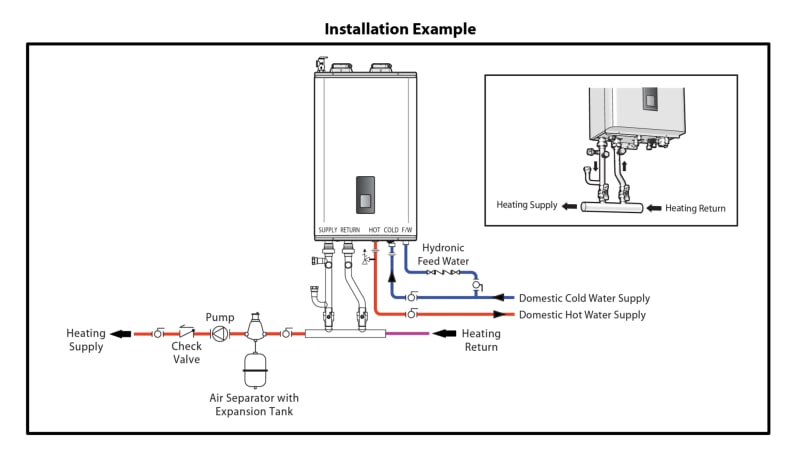disruptoergosum
Aerospace
- Jun 17, 2021
- 17
Question du jour about sizing tankless water heaters (instantaneous type):
Tankless water heater installed in conjunction with a hydronic heating coil in an air handler.
-Tankless input: 160,000 BTU/h
-Tankless output: 157,670 BTU/h
-Space heating capacity (Hydronic coil with air handler): 25,025 BTU/h (based on water temperature coil inlet 120F, coil outlet 94F, ΔT= 26F @ 2.0 GPM)
-Ground water temperature = 42 F
-DHW use prioritized over space heating and tankless modulates output
Temp rise & GPM for 160 kBTU/h unit
Temp Rise (°F) Flow Rate (GPM)
35 9.0
45 7.0
55 5.8
75 4.2
90 3.5
So 157,608 less 25,025 BTU/h=132,583 btu/h for DHW use, which if one uses a 78 °F ΔT [120°F-42°F], this works out to 3.4 GPM available for DHW (based on ..so two showers at 10 mins and 1.5 GPM draw from each results in 3.0 GPM and 0.4 GPM left for everything else that may be short & intermittent.
This in contrast to:
Other method I've seen estimates 99th percentile of peak DHW load based on Buchberger et al (referenced in ASHRAE Handbook- HVAC Applications, Chp 51 Service Water Heating, IP version) where one gets 5.8 GPM as the 99th percentile (exhaustive enumeration) with 8 fixtures.
Any suggestions or tips to improve analyses? Missing anything? Looking to see if a larger unit is more suitable for dual space heating/DHW application.
The profile of the 199 kBTU/h unit is:
Temp Rise (°F) Flow Rate (GPM)
35 11.2
45 8.7
55 7.2
75 5.2
90 4.4
Tankless water heater installed in conjunction with a hydronic heating coil in an air handler.
-Tankless input: 160,000 BTU/h
-Tankless output: 157,670 BTU/h
-Space heating capacity (Hydronic coil with air handler): 25,025 BTU/h (based on water temperature coil inlet 120F, coil outlet 94F, ΔT= 26F @ 2.0 GPM)
-Ground water temperature = 42 F
-DHW use prioritized over space heating and tankless modulates output
Temp rise & GPM for 160 kBTU/h unit
Temp Rise (°F) Flow Rate (GPM)
35 9.0
45 7.0
55 5.8
75 4.2
90 3.5
So 157,608 less 25,025 BTU/h=132,583 btu/h for DHW use, which if one uses a 78 °F ΔT [120°F-42°F], this works out to 3.4 GPM available for DHW (based on ..so two showers at 10 mins and 1.5 GPM draw from each results in 3.0 GPM and 0.4 GPM left for everything else that may be short & intermittent.
This in contrast to:
Other method I've seen estimates 99th percentile of peak DHW load based on Buchberger et al (referenced in ASHRAE Handbook- HVAC Applications, Chp 51 Service Water Heating, IP version) where one gets 5.8 GPM as the 99th percentile (exhaustive enumeration) with 8 fixtures.
Any suggestions or tips to improve analyses? Missing anything? Looking to see if a larger unit is more suitable for dual space heating/DHW application.
The profile of the 199 kBTU/h unit is:
Temp Rise (°F) Flow Rate (GPM)
35 11.2
45 8.7
55 7.2
75 5.2
90 4.4


